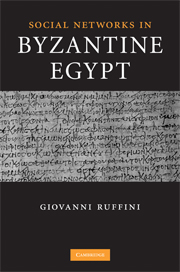Book contents
- Frontmatter
- Contents
- Dedication
- List of figures
- List of tables
- Acknowledgements
- References and abbreviations
- Introduction
- Chapter 1 The centralized elite of Oxyrhynchos
- Chapter 2 The growth of the Apions
- Chapter 3 Aphrodito and the strong ties of village society
- Chapter 4 Quantifying Aphrodito's social network
- Conclusion
- Stemmata
- Bibliography
- Subject index
- Index locorum
Introduction
Published online by Cambridge University Press: 26 June 2009
- Frontmatter
- Contents
- Dedication
- List of figures
- List of tables
- Acknowledgements
- References and abbreviations
- Introduction
- Chapter 1 The centralized elite of Oxyrhynchos
- Chapter 2 The growth of the Apions
- Chapter 3 Aphrodito and the strong ties of village society
- Chapter 4 Quantifying Aphrodito's social network
- Conclusion
- Stemmata
- Bibliography
- Subject index
- Index locorum
Summary
The feudal model is also by necessity for Egypt an “Oxyrhynchus model.” This is because the mass of evidence for large Egyptian estates and great landowners in the sixth century has Oxyrhynchus as its provenance; and much of that concerns one family, the high-ranking family of the Apiones … Nevertheless, for the past fifteen years or so, despite obstacles, there has been a turning toward the evidence of Aphrodito, giving it equal time with that of Oxyrhynchus. Much there runs counter to the Oxyrhynchus model. In its place, or, better, side-by-side with it, the Aphrodito papyri present a picture of a vibrant agricultural community of small landholders, farmers, craftsmen, priests, monks and shepherds … where big landowners may be present but do not rule.
James Keenan, 1993Byzantine Egypt produced social networks of differing shape and size. This book explores two of those networks. The first network in this study is nome-wide, that of the Oxyrhynchite nome's elite office-holders and families. This study examines the process by which one of those elite families grew its estates and influence to considerable proportions. The evidence available to us reveals this network's tendency towards hierarchy and social centralization. The second network in this study is that of a single village. This study looks at Aphrodito's self-styled “small landowners,” farmers, shepherds, craftsmen and others. It then measures the levels of interconnectivity among and social distance between these groups. This picture shows a remarkable degree of social parity and decentralization.
These two pictures are not mutually exclusive.
- Type
- Chapter
- Information
- Social Networks in Byzantine Egypt , pp. 1 - 40Publisher: Cambridge University PressPrint publication year: 2008



